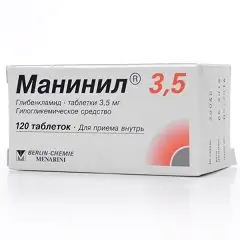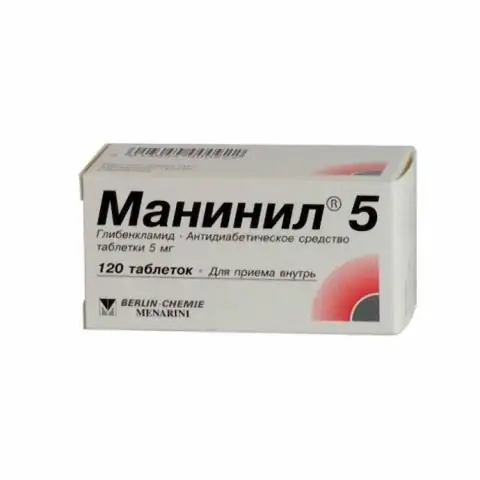- Author Rachel Wainwright [email protected].
- Public 2023-12-15 07:39.
- Last modified 2025-11-02 20:14.
Maninil 3.5
Maninil 3.5: instructions for use and reviews
- 1. Release form and composition
- 2. Pharmacological properties
- 3. Indications for use
- 4. Contraindications
- 5. Method of application and dosage
- 6. Side effects
- 7. Overdose
- 8. Special instructions
- 9. Application during pregnancy and lactation
- 10. Use in childhood
- 11. In case of impaired renal function
- 12. For violations of liver function
- 13. Use in the elderly
- 14. Drug interactions
- 15. Analogs
- 16. Terms and conditions of storage
- 17. Terms of dispensing from pharmacies
- 18. Reviews
- 19. Price in pharmacies
Latin name: Maninil 3,5
ATX code: A10BB01
Active ingredient: glibenclamide (Glibenclamide)
Producer: Berlin-Chemie / Menarini Pharma, GmbH (Berlin-Chemie / Menarini Pharma, GmbH) (Germany)
Description and photo update: 2020-18-08
Prices in pharmacies: from 118 rubles.
Buy

Maninil 3.5 is an oral hypoglycemic agent.
Release form and composition
Dosage form - tablets: flat-cylindrical, pink, with a chamfer and a line on one side (in a cardboard box 1 transparent glass bottle containing 120 tablets, and instructions for use of Maninil 3.5).
Composition of 1 tablet:
- active ingredient: glibenclamide (in micronized form) - 3.5 mg;
- excipients: colloidal silicon dioxide, potato starch, hyetellose, magnesium stearate, lactose monohydrate, crimson Ponso 4R (E124) dye.
Pharmacological properties
Pharmacodynamics
Glibenclamide is a hypoglycemic agent from the second generation sulfonylurea group.
Reducing the threshold of glucose irritation of the beta cells of the pancreas by binding to specific receptors of their membrane, the drug stimulates the secretion of insulin. Glibenclamide increases insulin sensitivity, increases the degree of its binding to target cells, enhances the release of insulin and its effect on the absorption of glucose by the liver and muscles, as a result of which the concentration of glucose in the blood decreases. It also inhibits lipolysis in adipose tissue.
Glibenclamide acts in the second stage of insulin secretion. Reduces the thrombogenic properties of blood. It has hypolipidemic activity.
In tablets Maninil 3,5 glibenclamide is present in micronized form, which is a high-tech, specially crushed form of the substance. Due to which it is rapidly absorbed from the gastrointestinal tract.
Considering the earlier achievement of the maximum plasma concentration (C max), the development of the hypoglycemic effect in time practically corresponds to the increase in the concentration of glucose in the blood plasma after a meal. This property makes Maninil 3.5 softer and more physiological in action.
The duration of the effect of the drug depends on the dose taken and can be up to 24 hours.
Pharmacokinetics
After oral administration, glibenclamide is rapidly and almost completely absorbed. The degree of absorption of the drug does not depend on the simultaneous intake of food. The micronized active substance is completely released within 5 minutes. C max reaches after 1-2 hours.
About 98% of the dose taken is associated with plasma proteins. The drug is completely metabolized in the liver, resulting in the formation of two inactive metabolites. One is excreted by the kidneys, the second with bile.
The half-life (T 1/2) is in the range from 2 to 5 hours. Excretion of the drug may be slowed down in patients with liver dysfunction.
In renal failure, the excretion of metabolites in the bile increases compensatory. With creatinine clearance (CC)> 30 ml / min, the total elimination remains unchanged. In patients with severe renal insufficiency, glibenclamide can accumulate in the body.
Indications for use
Maninil 3.5 is prescribed for type 2 diabetes mellitus as a monopreparation or as part of combination therapy simultaneously with other oral hypoglycemic agents, with the exception of glinides and sulfonylurea derivatives.
Contraindications
Absolute:
- type 1 diabetes mellitus;
- condition after resection of the pancreas;
- diabetic ketoacidosis, diabetic precoma and coma;
- intestinal obstruction, gastric paresis;
- severe renal failure (CC <30 ml / min);
- severe liver failure;
- deficiency of glucose-6-phosphate dehydrogenase or lactase;
- glucose and lactose malabsorption syndrome;
- hereditary lactose intolerance;
- leukopenia;
- decompensation of carbohydrate metabolism in conditions requiring insulin therapy (infectious diseases, burns, trauma, major surgical interventions);
- children up to age 18;
- period of pregnancy and lactation;
- hypersensitivity to any component of Maninil 3.5; to other sulfonylurea derivatives, sulfonamides, probenecid, as well as diuretics, the molecule of which contains a sulfonamide group.
Relative (Maninil 3.5 tablets should be used with extreme caution):
- conditions accompanied by impaired absorption of food and the risk of hypoglycemia;
- febrile syndrome;
- dysfunction of the thyroid gland;
- hypofunction of the adrenal cortex or anterior pituitary gland;
- acute alcohol intoxication;
- chronic alcoholism;
- cerebral atherosclerosis;
- elderly age over 70 years.
Maninil 3.5, instructions for use: method and dosage
Maninil 3.5 should be taken orally before meals, without chewing, with sufficient water.
If the daily dose of the drug is 1-2 tablets, they should be taken 1 time per day, before breakfast. Daily doses of more than 2 tablets should be divided into 2 doses, morning and evening, in a ratio of 2 ÷ 1.
If you miss the next dose, you must take the next dose at the usual time. It is forbidden to take a higher dose.
The optimal therapeutic dose of Maninil 3.5 depends on the severity of the diabetes mellitus, the patient's age, as well as the fasting blood glucose level and 2 hours after eating.
It is recommended to start treatment with a dose of 1.75 or 3.5 mg (½ or 1 tablet) 1 time per day. If it is not possible to achieve adequate metabolic control, the dose is increased in stages, under the close supervision of a physician. The increase is carried out at intervals of 2-7 days until the desired therapeutic effect is achieved. However, the maximum dose should not exceed 10.5 mg per day (3 tablets).
Because of the risk of hypoglycemia, the initial and maintenance doses are reduced for the elderly and frail people, patients with liver / kidney dysfunction, and those who are malnourished.
The transfer of patients to Maninil 3.5 from other hypoglycemic agents is carried out under close medical supervision. Treatment begins with a daily dose of 1.75 or 3.5 mg and gradually increases to the required therapeutic dose.
Side effects
The listed undesirable effects that may occur while taking the drug are classified as follows: often - from> 1/100 to 1/1000 to 1/10 000 to <1/1000, very rarely - <1/10 000, including individual messages …
Maninil 3.5 can cause the following side effects:
- on the part of metabolism and nutrition: often - an increase in body weight, hypoglycemia;
- from the gastrointestinal tract: infrequently - a metallic taste in the mouth, abdominal pain, belching, diarrhea, a feeling of heaviness in the stomach, nausea, vomiting;
- from the liver and biliary tract: very rarely - intrahepatic cholestasis, a temporary increase in the activity of liver enzymes, hepatitis;
- on the part of the blood and lymphatic system: rarely - thrombocytopenia; very rarely - erythropenia, leukopenia, pancytopenia, agranulocytosis, hemolytic anemia;
- from the immune system: infrequently - increased photosensitivity, purpura, urticaria, petechiae, itching; very rarely - anaphylactic shock, allergic vasculitis, generalized allergic reactions, accompanied by symptoms such as fever, skin rash, arthralgia, proteinuria, jaundice;
- others: very rarely - accommodation disorders, visual impairment, hyponatremia, transient proteinuria, increased diuresis; while taking alcohol - disulfiram-like reaction (feeling of heat of the skin of the face and upper body, tachycardia, abdominal pain, nausea, vomiting, headache, dizziness).
Overdose
The main symptom of an overdose of Maninil 3.5 is hypoglycemia, manifested by hunger, drowsiness, weakness, hyperthermia, tachycardia, skin moisture, general anxiety, headache, impaired coordination of movements, tremors, fear and transient neurological disorders such as changes in sensory perception, speech disorders, speech disorders, paresis, paralysis. If the condition worsens, the patient may lose self-control and consciousness. There is a high risk of developing hypoglycemic coma.
In case of mild symptoms of hypoglycemia, it is necessary to eat a sugar cube as soon as possible, take food or a drink containing a large amount of sugar, for example, honey, jam, sweet tea.
If the patient becomes unconscious, they require intravenous administration of 40% glucose / dextrose (40-80 ml) followed by an infusion of 5-10% dextrose solution. Further, if necessary, 1 mg of glucagon is administered (subcutaneously, intramuscularly or intravenously). If the patient does not regain consciousness, this measure is repeated. In some cases, intensive care is necessary.
special instructions
During the period of hypoglycemic therapy, patients should strictly adhere to all doctor's prescriptions regarding adherence to diet and self-monitoring of blood glucose.
The risk of hypoglycemia increases significantly in the case of untimely meals and starvation, insufficient carbohydrate supply to the body, with intense physical exertion, diarrhea and vomiting.
Symptoms of hypoglycemia can be masked by autonomic neuropathy and drugs that affect the central nervous system or lower blood pressure.
In older people, the risk of developing hypoglycemia is slightly higher, therefore, they are more carefully selected the dose and carry out special control of the concentration of glucose in the blood on an empty stomach and after meals, especially at the initial stage of therapy.
In the case of alcohol intake, hypoglycemia and a disulfiram-like reaction may develop, therefore, one should refrain from drinking alcohol during treatment.
In case of extensive burns, trauma, major surgical interventions and infectious diseases with a febrile syndrome requiring insulin therapy, it is necessary to cancel Maninil 3.5 and other oral hypoglycemic agents if combined therapy is performed.
Patients are not recommended to stay in the sun for a long time during treatment.
Influence on the ability to drive vehicles and complex mechanisms
Given the risk of developing adverse reactions that can affect the speed of reactions and the ability to concentrate, patients are advised to exercise caution when driving and performing potentially hazardous activities.
Application during pregnancy and lactation
Maninil 3.5 tablets are contraindicated for pregnant and breastfeeding women.
If pregnancy is diagnosed during treatment, the drug should be discontinued.
Pediatric use
Maninil 3.5 is not used to treat patients under 18 years of age.
With impaired renal function
The drug should not be prescribed to patients with severe renal failure, in whom the creatinine clearance rate is less than 30 ml / min.
For violations of liver function
A hypoglycemic agent is contraindicated in patients with severe hepatic impairment.
Use in the elderly
With caution, Maninil 3.5 tablets should be used to treat the elderly over 70 years of age, since they have a high risk of developing hypoglycemia.
Drug interactions
The hypoglycemic effect of Maninil 3.5 is enhanced by the following drugs: insulin, other oral hypoglycemic agents (for example, biguanides, acarbose), angiotensin-converting enzyme (ACE) inhibitors, beta-blockers, non-steroidal anti-inflammatory drugs (NSAIDs), coumarin derivatives, coumarin derivatives, monoamine oxidase (MAO) inhibitors, pyrazolone derivatives, clofibrate and its analogs, male sex hormones, anabolic agents, phosphamides (for example, cyclophosphamide, ifosfamide, trophosphamide), antifungal drugs (fluconazole, miconazole), para-aminosalienteraxylic acid formulations in high doses, salicylates, sulfonamides, fenfluramine, disopyramide, probenecid, fluoxetine, chloramphenicol, azapropazone, perhexiline, tritoqualin.
The effect of Maninil 3.5 is enhanced by drugs that acidify urine, since they reduce the degree of dissociation of glibenclamide and increase its reabsorption.
Reserpine, guanethidine, clonidine, beta-blockers and drugs with a central mechanism of action, in addition to enhancing the hypoglycemic effect of glibenclamide, can weaken the symptoms of hypoglycemia.
The hypoglycemic effect of Maninil 3.5 is reduced by the following drugs: barbiturates, glucocorticosteroids (GCS), thiazide diuretics, preparations of iodine-containing thyroid hormones, oral contraceptives, estrogens, sympathomimetic drugs, nicotinates (in large doses), slow calcium channel blockers, slow calcium channel blockers, lithium, rifampicin, phenytoin, glucagon, isoniazid, acetazolamide, diazoxide.
Antagonists of H 2 -histamine receptors can both weaken and enhance the effect of glibenclamide.
In rare cases, pentamidine can significantly reduce or greatly increase blood glucose concentration.
Maninil 3.5 is able to both reduce and increase the effect of coumarin derivatives.
Analogs
Analogues of Maninil 3.5 are Glibenclamide, Glidiab, Gliclada, Glyurenorm, Golda MV, Diabetalong, Diabefarm, Maninil 1.75; Maninil 5, Statiglin, Yuglin, etc.
Terms and conditions of storage
Keep out of the reach of children at a temperature not exceeding 25 ° C.
The shelf life is 3 years.
Terms of dispensing from pharmacies
Dispensed by prescription.
Reviews about Maninil 3.5
According to reviews, Maninil 3.5 is an effective drug that rapidly lowers high blood sugar levels. Small tablets, easy to swallow.
The disadvantages include a large list of contraindications. Often, patients complain about the development of side effects, such as weakness, headache, feeling unwell, dizziness, and vomiting.
Price for Maninil 3.5 in pharmacies
The price of Maninil 3.5 in the form of tablets is 100-185 rubles. per pack of 120 pcs.
Maninil 3.5: prices in online pharmacies
|
Drug name Price Pharmacy |
|
Maninil 3.5 3.5 mg tablets 120 pcs. 118 RUB Buy |

Maria Kulkes Medical journalist About the author
Education: First Moscow State Medical University named after I. M. Sechenov, specialty "General Medicine".
Information about the drug is generalized, provided for informational purposes only and does not replace the official instructions. Self-medication is hazardous to health!






